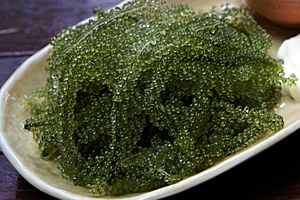Caulerpa lentillifera facts for kids
Quick facts for kids Caulerpa lentillifera |
|
|---|---|
 |
|
| Scientific classification | |
| Genus: |
Caulerpa
|
| Species: |
lentillifera
|
Caulerpa lentillifera is a type of green algae that grows in the ocean. It's often called sea grapes or green caviar because it looks like tiny green grapes! This seaweed is popular in coastal areas of the Asia-Pacific region. People love to eat it because it's soft and juicy.
Sea grapes are a traditional food in many places. You'll find them in the cooking of Southeast Asia, Oceania, and East Asia. Farmers first started growing sea grapes for sale in the Philippines in the 1950s. Later, in 1986, Japan also began to farm them. Today, these two countries are still the biggest fans and eaters of C. lentillifera. Growing sea grapes has also spread to other countries like Vietnam, Taiwan, and China.
Contents
Growing Sea Grapes for Food
For a long time, people just collected sea grapes from the wild. But then, something interesting happened in the Philippines in the 1950s. Sea grapes accidentally started growing in fish ponds in Cebu. This led to the first time sea grapes were grown on farms!
Today, there are about 400 hectares of ponds in Cebu used for growing sea grapes. That's a lot of space! These farms produce about 12 to 15 tons of fresh sea grapes every year. Farmers usually harvest the sea grapes about two months after planting them. After that, they can harvest more every two weeks, depending on how fast they grow.
Japan started growing sea grapes commercially in 1986. They grow them in tanks in the warm waters of Okinawa. Now, other countries like Vietnam, Taiwan, and China (in Fujian and Hainan) also grow them. Most of these sea grapes are eaten in the country where they are grown. But some are also sent to Japan.
How Do People Eat Sea Grapes?
Sea grapes, both Caulerpa lentillifera and its cousin C. racemosa, have been a part of meals for a long time. People in Southeast Asia, Oceania, and East Asia enjoy them. They are almost always eaten fresh and raw. You can eat them by themselves or mix them into salads. People say they taste "like the ocean," which sounds pretty cool! They are also known to have a lot of iodine, which is good for you.
Sea Grapes in the Philippines
In the Philippines, sea grapes are often called latô or arosep. First, they are washed very well. Then, they are usually eaten raw as a salad. This salad is called ensaladang lato. It's made by mixing the sea grapes with chopped raw shallots and fresh tomatoes. A dressing is added, usually a mix of fish sauce or bagoong (which is a fish paste) and vinegar. Sea grapes have also become popular in the Malaysian state of Sabah. This is because the Bajau people, who traditionally eat them, moved there.
Sea Grapes in Japan
In Okinawa, Japan, sea grapes are known as umi-budō (海ぶどう). This name means "sea grapes" in Japanese. Sometimes they are also called kubiretsuta. In Okinawa, people often dip umi-budō in ponzu sauce. Ponzu is a citrus-based sauce. You can also find sea grapes used in sushi, added to salads, or simply eaten plain as a snack.
Sea Grapes in Other Countries
Sea grapes are also enjoyed in Vietnam. There, they are called rong nho or rong nho biển, which means "grape algae." In Korea, they are known as bada podo (바다포도), also meaning "sea grapes." And in Indonesia, especially in Bali, they are called bulung. It's amazing how many different names and ways there are to enjoy this unique ocean plant!
Images for kids
-
Ensaladang latô from the Philippines, prepared with vinegar, fish sauce, shallots, and tomatoes
-
Umi-budō served Okinawan style
-
Fresh latô sold at a fish market in the Philippines




